Complacency Kills: The crash of Continental Airlines flight 1713
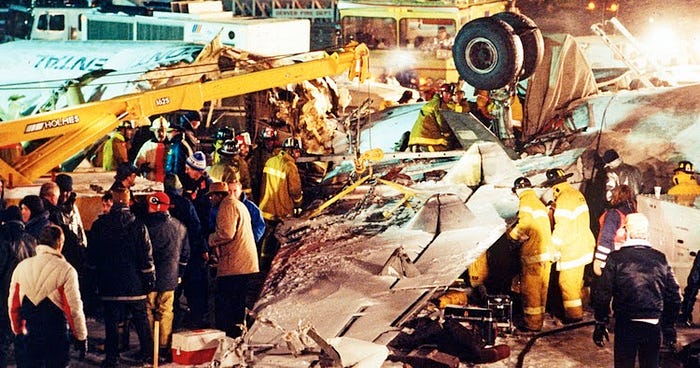
On the 15th of November 1987, a Continental Airlines DC-9 lost control seconds after takeoff from Denver, Colorado, sending the plane sliding upside down off the runway amid blinding snow. After a delicate operation to free dozens of people trapped under the upturned wreckage, the toll became clear: of the 82 passengers and crew aboard Continental flight 1713, 28 had died, and 54 survived. National Transportation Safety Board investigators would find that the disaster in Denver was one of many involving ice on the wings, a common threat to which the DC-9 was exceptionally vulnerable, and which many pilots and airlines continued to overlook, despite mounting evidence of the danger. The ill-fated takeoff was in fact defined by the unfortunate combination of this ever-present risk with an unprepared, inexperienced, and complacent crew, whose mistakes contributed to a steady escalation toward tragedy over a period of half an hour, which could have been interrupted at any point by a little bit of healthy caution — a reminder that when conditions are suboptimal, there’s no such thing as too careful.
◊◊◊
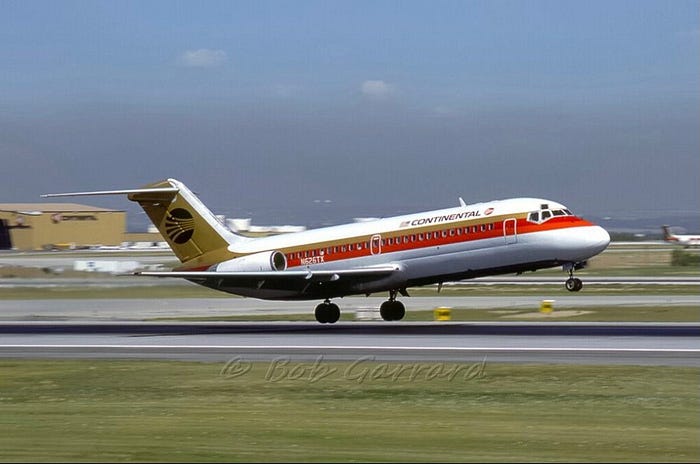
The first snowstorm of the winter season is often a hectic time at a major airport, as pilots, dispatchers, ground crews, and passengers readjust to the realities of cold weather operations. And every year, it’s the first time for some — whether new to their jobs or new to snow in general, the learning curve can be steep.
The crew of Continental Airlines flight 1713, a regularly scheduled flight from Stapleton Airport in Denver, Colorado, to Boise, the capital of Idaho, likely found themselves in such a situation on the afternoon of the 15th of November, 1987. The pilot in command, 43-year-old Captain Frank Zvonek Jr., had just flown in from his home in sunny San Diego late that morning, arriving at Stapleton minutes before his scheduled appearance time to find that the airport was being blanketed by the first winter storm of the 1987–1988 winter season, with heavy, wet snow piling up across the Denver area. It was also the first snow of his career as a DC-9 pilot, which had begun only in April after years flying Cessna Citation private jets. He had over 12,000 flying hours, no doubt including many in winter, but he had only 166 hours in the DC-9, including just 33 as captain. This was only his third trip sequence in the position — but that still made him the more experienced of the two pilots that day.
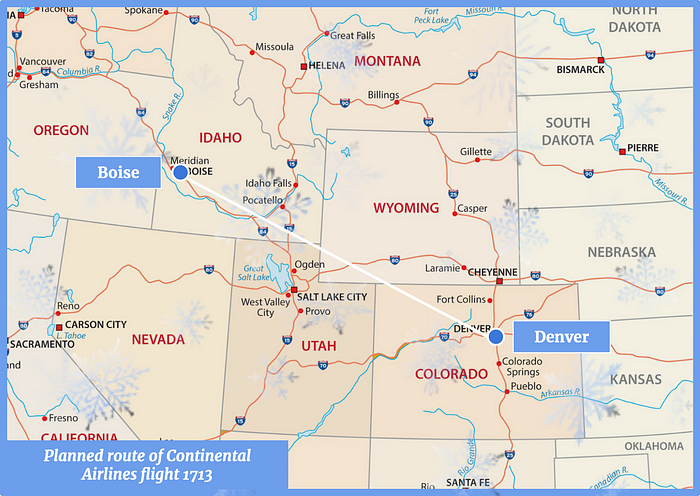
Captain Zvonek’s copilot on flight 1713 was 26-year-old First Officer Lee Bruecher, a new hire who had joined Continental on July 20th. Unknown to anyone at the airline, however, was that Bruecher’s respectable 3,200 flying hours masked a sordid series of failures and training difficulties. Most of those hours had been accrued on the twin turboprop Beech 1900, which Bruecher flew on behalf of several regional airlines during the mid-1980s. That he spent that time jumping between multiple carriers was no coincidence. His training got off to a poor start when the FAA instructor who coached him had his license revoked for skipping examination items. Then in March 1985, he was let go from one airline after failing three check rides, despite receiving twice as much training as other pilots; instructors recalled that he made grievous errors such as descending below the minimum descent altitude on instrument approaches, stepping on the wrong rudder pedal after simulated engine failures, and failing to feather a windmilling propeller. He struggled with deviations from routine operations and sometimes became disoriented. His employer clearly put significant effort into trying to smooth out his difficulties, but while he was said to have understood his limitations and wanted to learn, he seemed incapable of doing so.
Nevertheless, just days after his firing, he was hired by another company, where instructors again noted his difficulties with memory items, instrument approaches, and disorientation. As a result of these struggles he failed an FAA type rating examination in 1986, but was able to pass on a later attempt, eventually rising to the rank of Captain on the 19-passenger Beech 1900. From there, he made the leap to Continental — a major carrier that was still struggling with heavy pilot turnover after shutting out its unionized crewmembers in 1983. Those who returned were offered half their previous pay, and there was reason to believe that when it came to hiring new pilots to fill the gaps, Continental was starting to scrape the bottom of the barrel.
The airline would later claim to be unaware of Bruecher’s past, but he manifested many of the same deficiencies when Continental tried to train him on the DC-9. He struggled with his instrument scans, made jerky control inputs, and had a hard time staying within airspeed and altitude limits, and on one occasion he lost control of the simulator during an engine failure scenario at 2,000 feet, reaching 60 degrees of bank before the instructor was forced to take over. Nevertheless, he eventually passed his examinations and was admitted to Continental’s First Officer corps — only to be moved immediately to “reserve pilot” status, flying only when other Continental pilots failed to show. By the time of flight 1713, he had accumulated only 36 hours on the DC-9, his first jet aircraft, and he hadn’t flown a single minute in the preceding 24 days. He had in fact been rostered on flight 1713 by intervention of Continental’s chief pilot, replacing a more senior first officer, in order to prevent his currency from expiring.
As the pilots of flight 1713 settled in to prepare for the flight, their scheduled departure time of 12:25 came and went, as the snowstorm caused delays throughout the network. United Airlines’ next flight from Denver to Boise had been cancelled, and passengers were desperate to rebook on flight 1713, creating chaos at the gate that complicated matters further. In the process, Captain Zvonek neglected to sign off on the dispatch paperwork, and he also failed to inform the dispatcher that because he had less than 100 hours as captain on the DC-9, he had higher visibility minimums for landing than other captains — a fact that would preclude him from returning to Denver after takeoff under the present weather conditions, should the need to do so arise. Had he mentioned this to the dispatcher, it was possible that he would have been replaced by a more experienced captain, and perhaps everything that followed might have been avoided — but such is the nature of our constantly branching reality.
By the time the gate had been sealed, there were 82 people aboard the DC-9, including 5 crewmembers and 77 passengers, leaving only 8 seats empty, mostly in business class. Up front, the crew were working out who would fly when — a ubiquitous task made somewhat more difficult today by the bad weather and their own inexperience. A flight attendant recalled being concerned about the return flight from Boise to Denver — was First Officer Bruecher experienced enough to handle landing in a snowstorm? Captain Zvonek, however, assured her that he would fly the return flight from Boise. Under the normal practice of “trading legs,” where the two pilots take turns flying a particular leg, that meant that Bruecher would fly the outbound leg to Boise, even though he would have to take off in the snowstorm. Neither pilot had ever flown a DC-9 in a snowstorm before, but Zvonek did not appear to be worried.
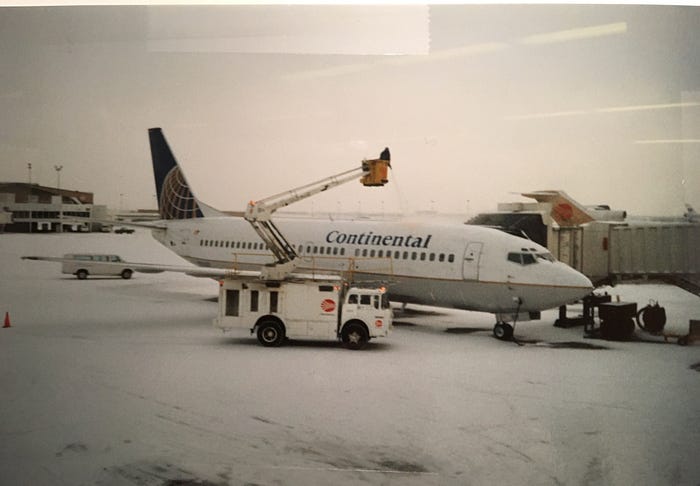
At 13:03, 38 minutes behind schedule and counting, flight 1713 received its route clearance from the clearance delivery controller, informing them of the route they would fly after takeoff. The pilots were aware that before takeoff they would need to go to the de-icing pad to remove snow and ice that had been accumulating on their wings, but there seemed to be some confusion about the order of operations. The proper procedure was to call ground control, ask for permission to taxi to the remote de-icing pad, then ask for clearance to taxi to the runway after de-icing was finished — but the pilots appeared not to recognize the need to contact ground control before heading to the de-icing pad, and so shortly after receiving their route clearance, they departed the gate without permission, leaving controllers none the wiser. In fact, with no ground radar and limited visibility in falling snow, the tower had no way of knowing that flight 1713 was no longer at the gate.
Unaware of their mistake, the crew taxied their DC-9 to the de-icing pad, where the de-icing technicians sprayed down their wings with a heated solution of glycol and water designed to remove ice and snow. As the de-icing fluid battered the plane, Captain Zvonek joked, “It’s like going through a car wash!”
By the time the de-icing concluded at 13:46, the wings appeared free of ice and snow. The pilots restarted their engines, then Captain Zvonek called clearance delivery to report, “Clearance, Continental seventeen thirteen, taxi from the ice pad.”
“Continental seventeen thirteen, monitor ground twenty one nine,” the clearance delivery controller said, handing them over to ground control for taxi instructions.
Moments later, ground control called and said, “Continental seventeen thirteen, left side taxi to the pad, give way to two company’s on the south side of Delta going into three, it’s an Airbus and a[n] MD-80.”
“Continental seventeen thirteen, roger,” Zvonek replied.
This exchange had failed to clear up the misunderstanding. Because flight 1713 never requested permission to taxi from the gate, the ground controller believed they wanted clearance to taxi from the gate to the de-icing pad, while the crew believed they were asking for clearance to taxi from the de-icing pad to the runway. However, by using the word “pad,” the ground controller left matters open to interpretation, and Zvonek and Bruecher evidently thought he meant the runup pad at the head of runway 35L, which was being used for departures.
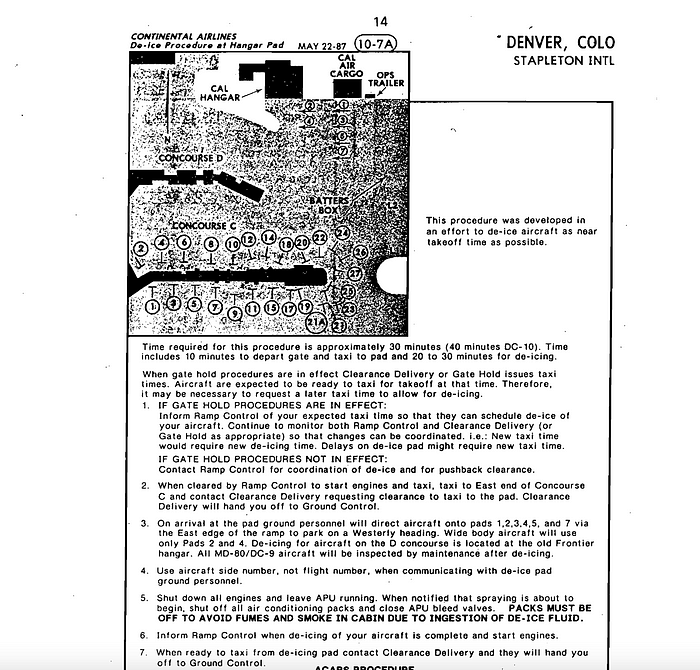
Still without proper permission, flight 1713 joined the queue for takeoff on runway 35L, taxiing across the airport amid steady snowfall. Arriving in the vicinity of the runway, they found two other Continental flights in line ahead of them, while two additional flights were waiting on the opposite side of the runup pad, having come from a different terminal. The pilots contacted the tower controller to await takeoff instructions.
As minutes passed, Continental flight 1149 was cleared for takeoff, then Continental flight 1617. “We’re next,” one of the pilots commented. Then another flight, Continental flight 65, was cleared to enter the runway from the opposite side. After that it would be flight 1713’s turn to taxi up to the edge of the runway, where they would await clearance to assume the takeoff position. But the tower controller was unaware of flight 1713’s presence — in fact, because of the series of miscommunications that had already taken place, the progress strip that controllers used to track its location indicated that it was still at the gate. Instead, the tower controller said, “Continental five ninety four, taxi up to and hold short.”
But this flight, Continental 594, was still at the de-icing pad, with its engines turned off and its pilots not monitoring the tower frequency. The controller repeated his instructions, but again there was no reply.
At that moment Captain Zvonek suddenly remembered that he was a “high minimums” captain and that the visibility was too low for him to return to Denver. But it was too late to do anything about that now — “We’ll have to call dispatch when we get to Boise to let ’em know,” he said.
The pilots then engaged in some idle commentary about the weather — lamenting the possibility that the storm might “hang in here” — before the tower cleared Continental flight 65 for takeoff. Immediately afterwards, the tower again contacted the absent flight 594: “Continental five ninety four, taxi into position and hold three five left, report in position,” he said. He was met with silence. “Continental five ninety four how do you hear?” he asked. Still nothing.
The tower controller now contacted the plane that he believed was next in line behind flight 594, but which was actually behind flight 1713. “Continental eight seventy five, how do you hear me?” he asked.
“Continental eight seventy five, loud and clear,” the flight replied.
“Thank you, can anybody see a[n] MD-80 going into position out there?” he asked.
Continental flight 594, the flight that the controller mistakenly thought was at the runway, was an MD-80, a stretched version of the DC-9. From behind, the two aircraft types would have looked very similar. Staring at the back end of flight 1713, the flight 875 pilot replied, “He ain’t moving.”
As the tower tried again to call flight 594, Captain Zvonek remarked to First Officer Bruecher, “You might, ah, tell him that we’re number one here on the north side.”
Keying his own mic, First Officer Bruecher said, “And Denver tower, er, yeah, Denver tower, Continental seventeen thirteen is number one, DC-9 for Continental.”
Appearing not to hear the transmission, the controller again said, “Continental five ninety four, tower?”
“It didn’t impress him at all,” Captain Zvonek joked.
“Apparently not,” said Bruecher.
“Continental eight seventy five, can you get around a company MD-80 for the runway?” the controller asked.
“Continental eight seventy five, affirmative,” the flight replied.
The tower then cleared flight 875 to taxi into position on the runway and hold, and the flight peeled out of the line to taxi around flight 1713 and onto the runway. As they watched the 737 enter the runway, First Officer Bruecher again called the tower and said, “And Denver tower, the number one Continental there at the runway is seventeen thirteen.”
“Roger, ah, I have a Continental five ninety four, would that be anybody — seventeen thirteen, are you an MD-80?” the tower asked.
“Negative sir, DC-9,” said Bruecher.
“Continental seventeen thirteen, roger,” said the tower.
“Okay, I think we got ’em straightened out now,” Zvonek remarked.
By this point, 21 minutes had passed since flight 1713 finished de-icing. By any measure, this was too long. The problem was that while the glycol solution that had been applied to flight 1713 was perfectly capable of melting any ice and snow that was already on the wings, it had only limited anti-icing properties, so it would not prevent ice from re-forming if precipitation continued to accumulate on the wing surfaces after de-icing. For this reason, Continental Airlines operating procedures required that the crew return to the pad to de-ice again if they did not take off within 20 minutes of de-icing. But from their conversations, it’s clear that the pilots of flight 1713 never considered doing so. After all, they were next in line, and the controller knew where they were, so they should be cleared to depart at any moment — right?
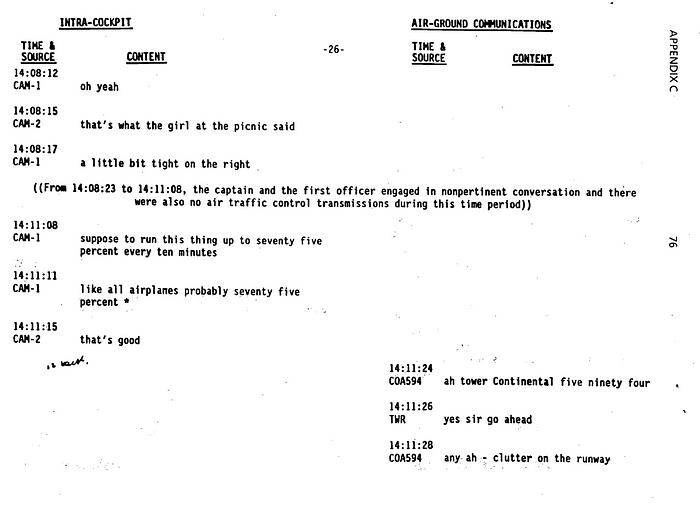
Unfortunately, it was not to be. Continental flight 875, which had taxied into the runway ahead of them, was instructed to wait for some time while an inbound flight landed on the parallel runway 35L, as visibility was too low to permit the two adjacent runways to be used simultaneously. While they waited, the pilots engaged in an off-topic conversation, reportedly about the dating habits of one of their flight attendants. Notably, they did not discuss the snow still falling around them, or the possibility that ice was again forming on the wings of their DC-9.
In fact, flight 1713 was not cleared to enter the runway until 14:12. Ahead of them, the now airborne flight 875 reported that there was “a little clutter” on the runway, which had some patches of slush but was mostly clear. At 14:14, First Officer Bruecher reported that they were in position, and the tower acknowledged with a “thank you.”
“Okay, red rover,” Captain Zvonek joked.
Bruecher laughed. “Bend over and bark like a dog!” he said.
“Got the brakes on, you got the airplane,” Zvonek said, handing control over to Bruecher for the takeoff. “I got the radio — run ’em up a little bit before you release the brakes and let them stabilize,” he said.
As Bruecher started to run up the engines, the tower cleared flight 1713 for takeoff, and Zvonek acknowledged. The pilots pushed the thrust levers all the way up to takeoff power, and at six seconds past 14:15, they were underway. By then, over 27 minutes had passed since they last de-iced — a delay that would soon have fatal consequences.
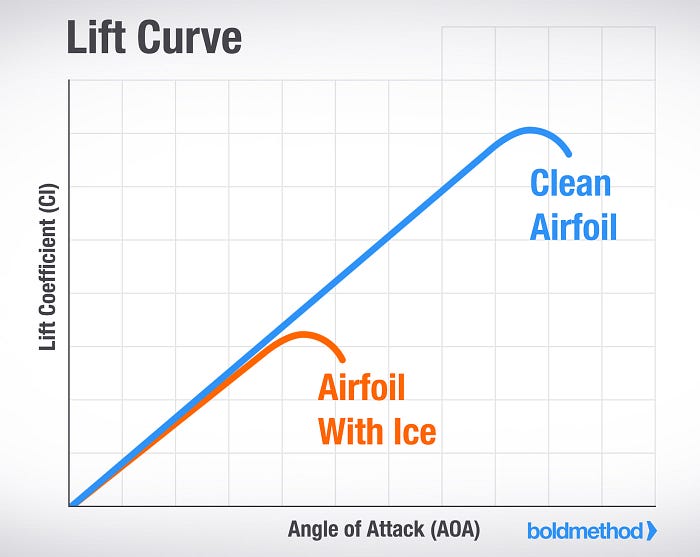
On the wings of flight 1713, imperceptible to most outside observers, was a thin layer of re-frozen ice. As wet snow fell on the wings during the flight’s lengthy delay, it diluted the water-glycol solution leftover from the de-icing, raising its freezing temperature. Water mixed with glycol freezes at a much lower temperature than pure water, but the lower the concentration of glycol becomes, the closer its freezing temperature comes to 0˚C. With the outside air temperature hovering at -2˚C (28˚F), and considering the high water content of the early season snow, the de-icing fluid on flight 1713’s wings became ineffective some time before it took off, allowing re-freezing to occur. A thin layer of rough, sandpaper-like ice less than a millimeter in thickness would have been enough to severely compromise the performance of the airplane.
The primary effect of ice on the wings is aerodynamic. The wing of an airplane, especially a high-performance swept wing like those on the DC-9, relies on very smooth airflow in order to generate lift. When the air ceases to flow smoothly over the top of the wings, it separates from the wing surface and becomes turbulent, triggering a stall, a catastrophic loss of lift. On an uncontaminated wing, the point at which this separation occurs naturally is dependent on the plane’s angle of attack, the angle of its lifting surfaces relative to the oncoming airstream. For a given aircraft configuration, the stall angle of attack is always the same, which makes it possible for the plane’s angle of attack sensors to provide a warning to the crew in advance of the stall. However, when there is rough ice on the wings, the cessation of smooth airflow occurs at a lower angle of attack, which can cause the airplane to stall before the stall warning goes off. Depending on the amount of ice on the wings, it may be impossible to become airborne at all, or the performance margins may be reduced. The latter was the case on flight 1713: the ice had not been accumulating for long enough to preclude a normal takeoff, but the pilots would need to be careful.
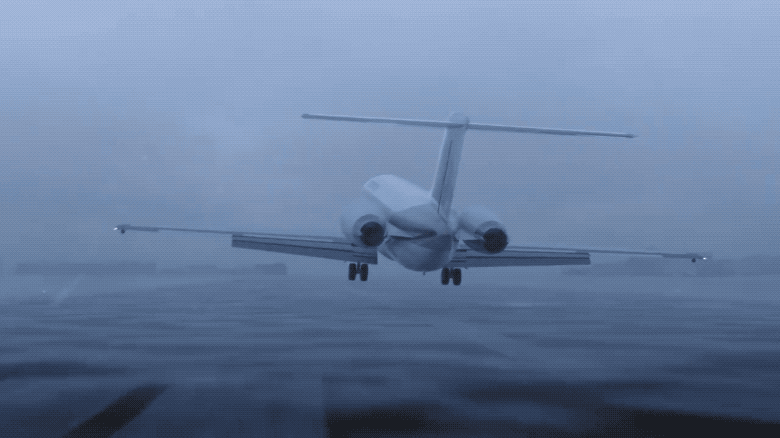
Unfortunately, the inexperienced crew of flight 1713 appeared oblivious to the danger. As they sped down the runway, Captain Zvonek called out, “There’s a hundred knots, looking for one thirty nine.” Seconds later, they reached 139 knots, and he called out, “V1. Rotate.”
Performing his first takeoff in nearly a month, First Officer Bruecher gripped the controls and hauled back to lift the nose. In the process, he severely over-rotated, bringing the nose up at six degrees per second, twice the recommended rate. With its main wheels still on the ground, the plane pitched up sharply, sending its angle of attack skyrocketing past the reduced stall margin. The plane lifted off the ground, and Captain Zvonek called, “Positive rate,” but they were already out of control. Without warning, the plane lost lift and sank back toward the ground, veering off the right side of the runway with its left wing hanging low. Bruecher shouted an expletive, his cry punctuated by a series of bangs from the engines as the disrupted airflow over the wings flowed back into their intakes, causing pressurized air to surge forward through the compressors. The left wing then struck the ground, dragging along the snowy earth, and the rest of the plane followed, slewing around the disintegrating wing until the cockpit slammed nose first into the ground. The cockpit voice recording abruptly ended, but the crash continued, as the plane bounced, spun around, and turned over onto its roof, its still attached right wing rising up and over the fuselage like a breaching whale, before at last the plane slid inverted to a halt, a long trail of debris strewn through the snow in its wake.
◊◊◊

On board the plane, those who survived found themselves in a situation unlike any they had ever imagined. The forward section had come to rest on its left side, while the center and aft sections were completely upside down, with passengers near the tail hanging by their seat belts from the ceiling. Farther forward, the cabin had been crushed down to less than 2 feet (0.6 m) in height, reducing to mere inches at row 15, fatally asphyxiating some passengers and trapping others amid a twisted jumble of cabin furnishings, bodies, dirt, and snow. Still others had been ejected from the plane, many of them to their deaths, but some survived, coming to their senses still strapped into their seats in the snow.
Although a few people were able to get up and walk away from the wreck, the vast majority were stuck inside the crushed airplane with no obvious exit. In the tail section, most of the passengers had survived with only minor injuries, and although the plane’s tail had broken off and come to rest some distance away, the cabin area remained intact — but that meant there were no breaks in the fuselage through which to escape. The most obvious escape route was through the DC-9’s tailcone exit door, but with the plane upside down, the hatch opened upward, and access to it was blocked by displaced portions of the lavatory structure. Flight attendants and passengers attempted to remove these obstacles, but they were initially unable to push through, and they did not escape until 7 to 10 minutes after crash. Thankfully, however, the plane did not catch fire — if it had, the situation would have been much worse.
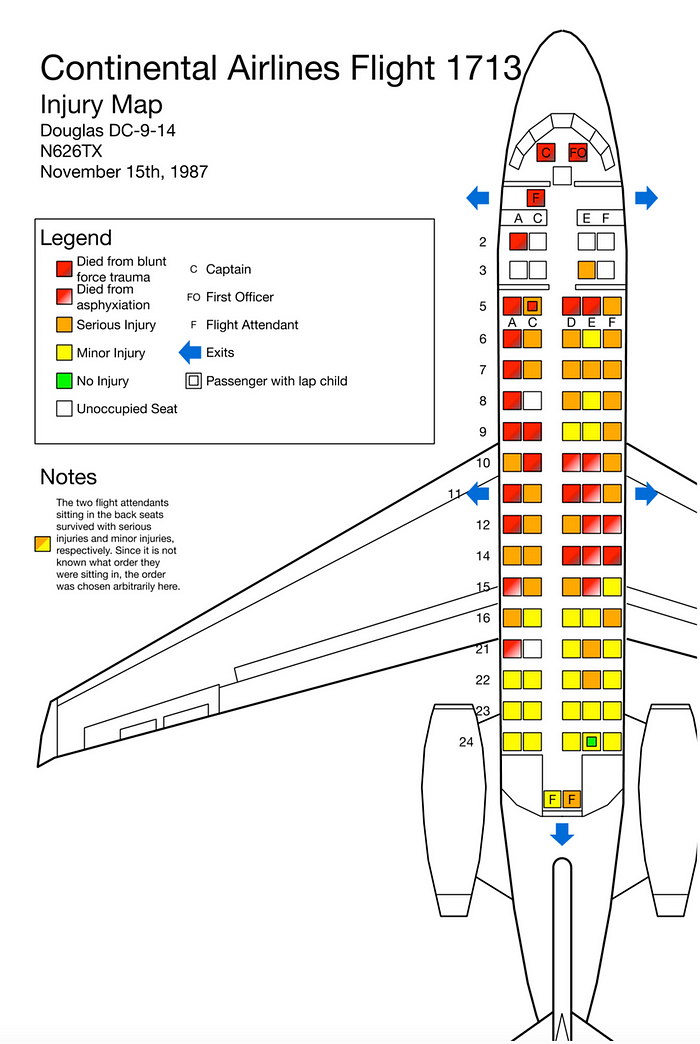
Firefighters and snow removal crews arrived on the scene within a short time after the crash, but the task they faced was daunting. Dozens of people were trapped inside the plane, and the inverted cabin could settle further at any moment, crushing people who initially survived the accident. As more and more emergency crews arrived, chaos reigned. Triage tags froze together; the pens used to write on them stopped working; survivors were placed inside emergency vehicles to warm up, only for the sound of running engines to drown out all attempts at radio communication. Hydraulic rescue jaws were brought in to cut away the fuselage and reach trapped survivors, but the generators used to power them threatened to ignite fuel leaking from the right wing. A tunnel was slowly carved through the debris to reach passengers stuck in the center wing section, but the right wing had to be propped up with wooden cribbing to prevent it from settling on top of survivors and rescuers alike. And then to make matters worse, the cribbing turned out to be made of pine, which was too flexible, and the wing continued to settle until rescuers finally managed to hold it up using two cranes, several straps, and a forklift. All the while, rescuers pushed deeper into their painstakingly excavated tunnel, which firefighters compared to working in a mineshaft.
In the end, the last survivor was not extracted until nearly four hours after the crash, as night fell over Denver. Many others were not so lucky. Of the 82 people on board, 54 survived, while 28 perished — 19 of them on impact, and 9 more due to mechanical asphyxiation while trapped in the wreckage. Among the dead were both pilots and the forward flight attendant, as well as most of the passengers in the front left part of the cabin, which bore the brunt of the impact.
◊◊◊
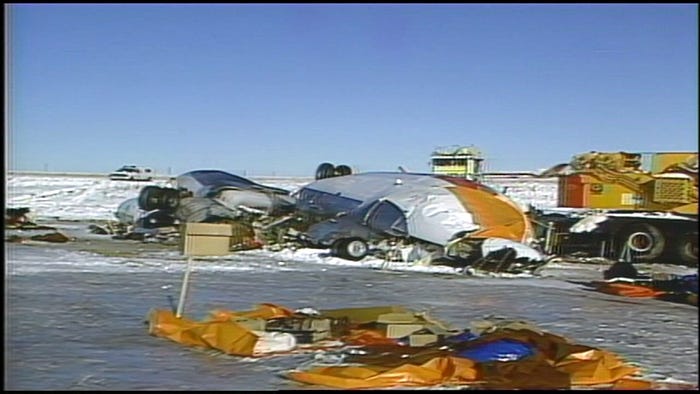
Investigating the crash fell to the National Transportation Safety Board, which sent a team of experts to examine all possible causes of the disaster. At issue was why flight 1713 failed to gain altitude and apparently lost control moments after liftoff.
Continental Airlines developed its own theory at an early stage of the investigation: that the flight was struck by wake turbulence from a wide body Boeing 767 that landed on the parallel runway 35R some three minutes earlier. Under the right conditions, vortices generated in the wake of large aircraft can cause smaller aircraft nearby to lose control, which can be especially dangerous in close proximity to the ground. Continental argued for this scenario in a report that they submitted several months into the investigation, but the NTSB was skeptical. Citing NASA research into wake turbulence, they noted that the distance between the two runways was likely too far for the turbulence to have traveled during the time between the 767’s landing and flight 1713’s takeoff, and in fact was well beyond the maximum observed travel distance for wake turbulence generated so low to the ground. Furthermore, given the wind speed and direction, even if the vortices did persist, they would have crossed runway 35L at a location early in flight 1713’s takeoff roll, not at the point where the loss of control occurred.
On the other hand, suspicion about the involvement of ice had been growing from an early stage in the investigation. The simple fact was that with 27 minutes having passed between de-icing and takeoff, there was ample time for ice to have begun re-forming on the wings before flight 1713’s ill-fated attempt to become airborne. The pilots of flight 875, which taxied past flight 1713 shortly before the crash, did not recall seeing any ice, but a thin layer of clear ice would not necessarily have been visible. Two passengers did recall seeing some ice and snow on the wings, however — one of whom later had his personal credibility attacked by Continental Airlines, probably for liability reasons.
Nevertheless, the NTSB was also able to prove their hypothesis mathematically. Given the water content of the snow and the precipitation rate, the NTSB believed that 0.03 in (0.76 mm) of rough ice could have formed on the wings of the DC-9 during the 27 minutes it sat on the ground after de-icing. Previous studies had already found that 0.03 inches of rough ice on the DC-9 could cause a 20% reduction in the maximum achievable lift, and could reduce the stall angle of attack from about 14 degrees to below 12 degrees. As a result, the airplane stalled before the stall warning activation threshold, and in fact the stall warning was not heard on the cockpit voice recorder at any point. The pilots likely never realized they were stalling — and once the stall began, the aerodynamic characteristics of the DC-9’s highly swept wings caused a loss of roll stability, the left wing hit the ground, and all was lost.
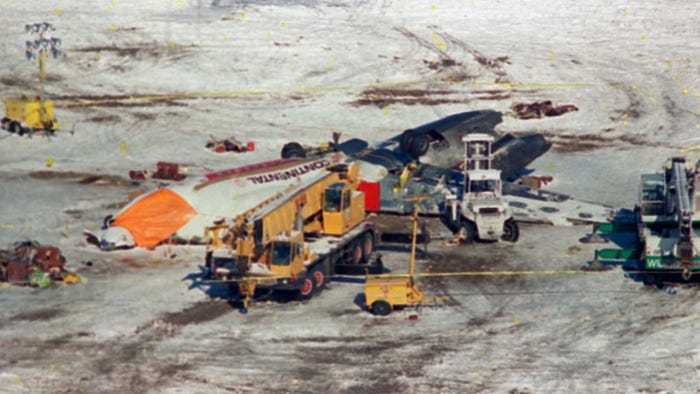
However, the flight data recorder showed that there was more to the story than simply ice on the wings. Although the data recorder did not track the plane’s pitch angle directly, it was possible to derive it from the altitude trace, which registered a dip below the runway elevation proportional to the takeoff pitch angle as a result of airflow changes around the static pressure sensors. This data showed that flight 1713 pitched up twice as fast as on a normal takeoff, at a rate of around 6 degrees per second, and may have reached a maximum pitch attitude of 14 degrees, much higher than the typical 9 degrees. Until a plane leaves the ground, its pitch angle and angle of attack are always equal, so it was certain that this rapid and excessive rotation resulted in an angle of attack greater than 12 degrees. The airspeed and vertical acceleration values at the point where the stall occurred also matched exactly the values calculated by the NTSB for a scenario in which the plane had 0.03 in of ice on its wings. These calculations confirmed that the ice and the rapid rotation were both essential to the accident sequence. Corollary to that conclusion, it was evident that if First Officer Bruecher had rotated normally for takeoff, the crash likely would not have occurred.
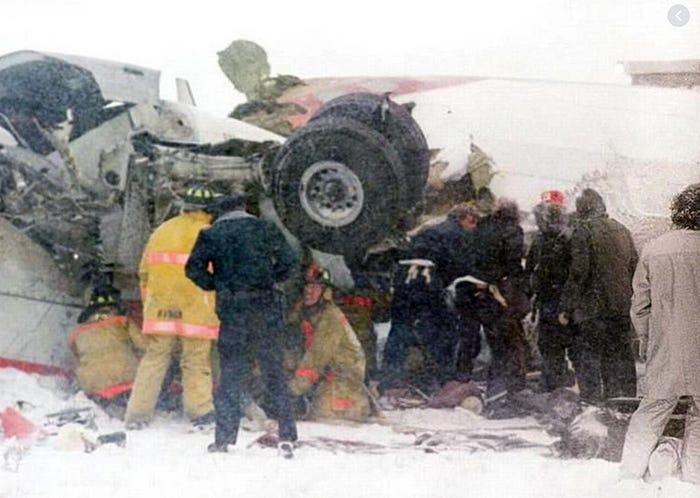
This finding led the NTSB to question several aspects of both the pilots’ decision-making, and the airline’s. A background check revealed that Bruecher was a troubled pilot who suffered from aptitude problems in areas as simple as control of the airplane, despite his best efforts to learn. This history made him a dubious candidate for upgrade to a jet airliner, but Continental told the NTSB that it was completely unaware of his difficulties at previous airlines. At that time, airlines were not required to examine an applicant’s training records from previous employers; instead, Continental hired a third party company to conduct a background check on Bruecher, which falsely characterized his prior performance as “very good.” Why and how the contract company came to this conclusion is unknown.
Once hired, Bruecher continued to experience the same difficulties, but the NTSB report does not indicate that he was added to any kind of special surveillance program, or even whether Continental had such a program. Furthermore, after completing training he was sent to the reserve pilot corps, giving him little opportunity to refine his already shaky piloting skills. Given all of these facts, it was unfortunately not surprising that Bruecher made a simple aircraft handling error. The NTSB believed that the 24 days he spent on the ground prior to the accident flight may have contributed to that mistake, but they could not determine the extent to which this was the case.
Considering that Bruecher had only 36 hours of jet experience and had not flown in nearly a month, facts of which Captain Zvonek was possibly aware, the NTSB questioned Zvonek’s decision to let him take off from Denver during a snowstorm. Evidently, Zvonek was more concerned about the landing in Denver on the return trip, but the relatively higher risk of landing obscured the still substantial risk of taking off. The NTSB suggested that in such a situation, the prudent thing to do might be for the captain to fly the takeoff, then hand over control to the first officer for the rest of the flight.
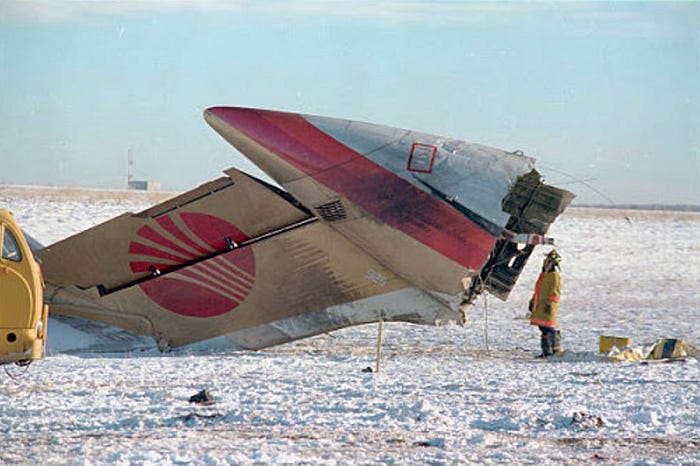
Captain Zvonek’s own inexperience in the role of captain may have contributed not only to this ill-advised decision, but to several others as well. He missed steps in the dispatch process, and then apparently misunderstood Continental Airlines’ procedures for taxiing to the de-icing pad, causing the flight to leave the gate without clearance. This error caused a departure delay of about nine minutes, because the ground controller developed a mistaken impression of flight 1713’s location, which was then passed on to the tower controller, who cleared another plane to taxi around the DC-9 and take off ahead of it. During this delay, the pilots engaged in off-topic conversation and neglected to consider a company policy requiring them to de-ice again if more than 20 minutes had passed between de-icing and takeoff. The belief that they would be cleared to take off at any moment, as well as the hassle of returning to the start of the line, may have deterred Captain Zvonek from seriously considering this course of action.
The NTSB noted that this dilemma could have been solved by better technology that was already available in Europe. European winter operations publications prescribed the use of type II de-icing fluid, which has much longer-lasting anti-icing capabilities, enabling planes to wait much longer than 20 minutes before dangerous quantities of ice can re-form. Had type II fluid been used, flight 1713 almost certainly would not have crashed. At that time, however, most US de-icing equipment didn’t support the use of the more viscous type II de-icing fluid, and its presence was extremely limited. As a result, the NTSB recommended that studies be conducted on the effectiveness and feasibility of bringing type II fluid to the United States. Although similar recommendations had to be re-issued after additional ice-related accidents in 1989 and 1992, these new solutions were eventually imported, and the anti-icing fluid in use today protects aircraft surfaces against re-freezing for as long as several hours.
Another takeaway from the accident was that the pairing of Zvonek and Bruecher may not have been appropriate, especially under the conditions. Zvonek’s 33 hours as captain and Bruecher’s 36 as first officer left them greatly wanting in practical DC-9 experience, and neither was able to act as a check on the mistakes of the other. Better pairings were surely available, but Continental Airlines did not have any means to avoid scheduling inexperienced pilots together, nor were any required. The NTSB recommended that this deficiency be corrected, and the FAA agreed, ultimately leading to the introduction in 1995 of minimum experience requirements for pilots rostered with an inexperienced colleague.
Other recommendations issued by the NTSB called for additional measures such as increased glycol concentrations in de-icing fluid for DC-9s, new means for DC-9 pilots to verify the absence of ice on their wings before takeoff, and more comprehensive background checks for prospective pilots, including examination of their training records, which is now a requirement.
◊◊◊
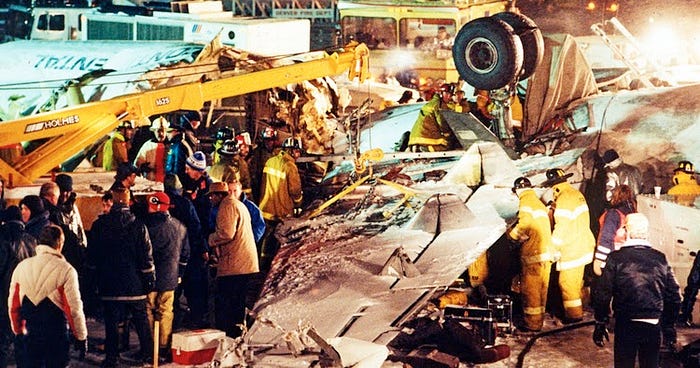
The substantial changes brought about by the crash of Continental flight 1713 had already begun making aviation safer by the turn of the millennium, but a number of more timeless lessons endure. The sequence of events that brought down flight 1713 was not complicated, and it was preventable. An understanding of risk goes a long way — whether that risk is posed by wintry weather or a pilot’s own inexperience. Captain Zvonek was aware of some of the risks that they might face that day, but the most immediate ones, the ones that were almost staring him in the face, somehow escaped him. The DC-9 had long been known as one of the most vulnerable aircraft types when exposed to small quantities of ice, in large part due to its highly swept wings and lack of leading edge slats. To some extent, Zvonek must have been aware of this, but evidently it had not figured strongly enough in his imagination on his first day flying the DC-9 in winter weather. He also must have known that he and his first officer lacked relevant experience, but somehow he never quite put two and two together. The killer, then, was complacency — the understandable but nevertheless naïve assumption that risks are abstract, that things will be fine, and that tragedy only befalls other people. In fact, risks are only abstract until they aren’t, and the more they are ignored, the more they build upon one another, until suddenly disaster is only one small error away. Perhaps there is an alternate universe in which Zvonek realized this fact, decided to monitor Bruecher’s takeoff a little closer, leaned in a little bit on his controls, kept the angle of attack just below the stall, and climbed away into the November sky, his passengers none the wiser. Instead, his life and the lives of 27 others ended on the margin of a snowy runway, leaving the rest of us to contemplate what could have been.
_______________________________________________________________
Join the discussion of this article on Reddit
Support me on Patreon (Note: I do not earn money from views on Medium!)
Visit r/admiralcloudberg to read and discuss over 240 similar articles
_______________________________________________________________
Note: this accident was previously featured in episode 53 of the plane crash series on September 8th, 2018, prior to the series’ arrival on Medium. This article is written without reference to and supersedes the original.
